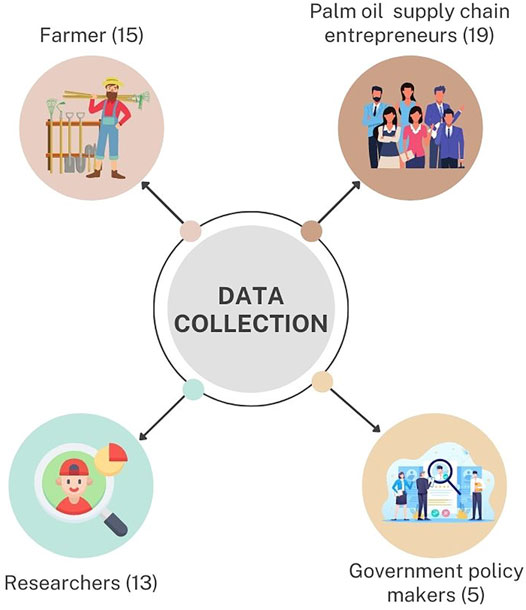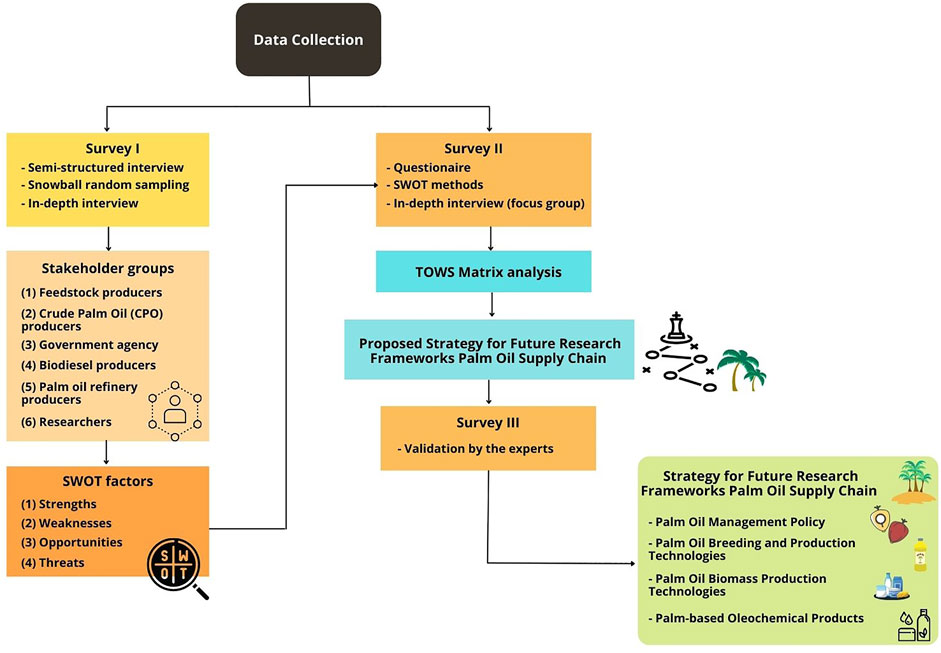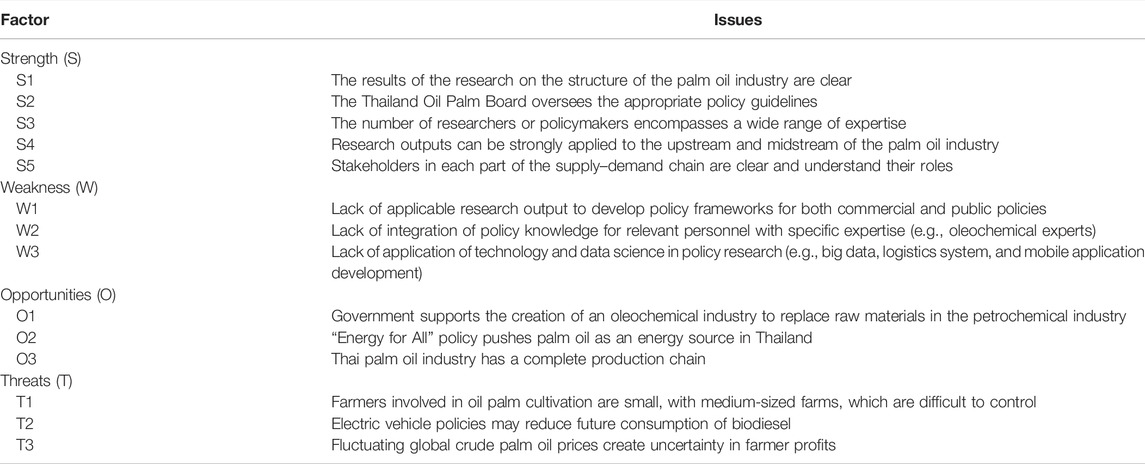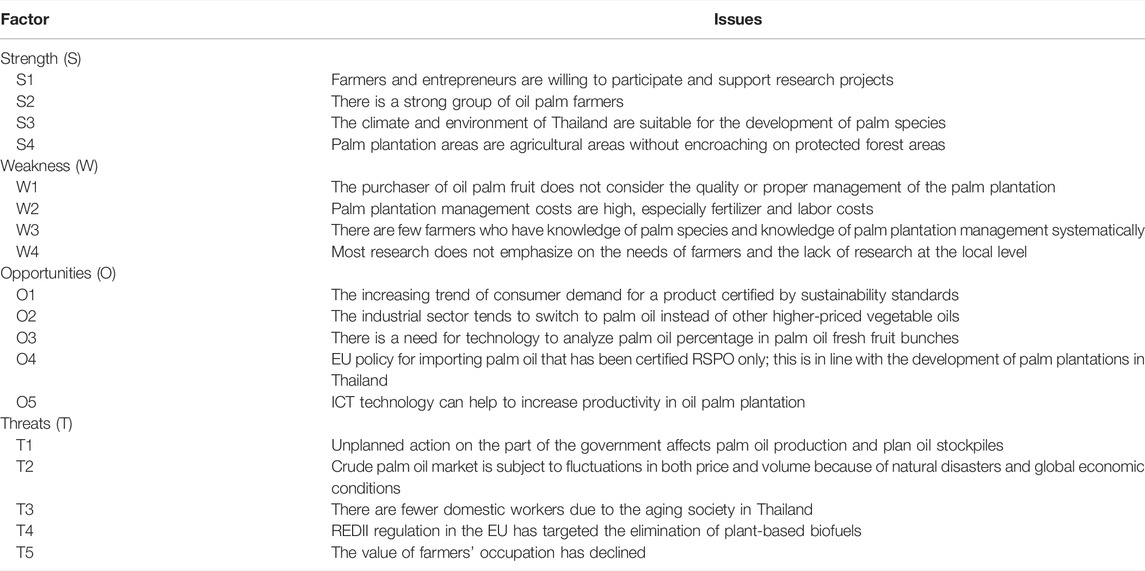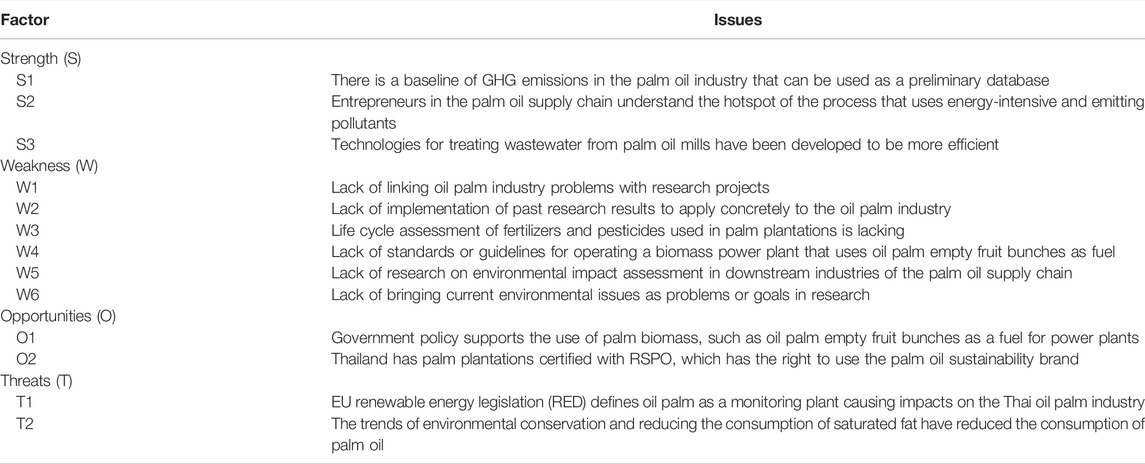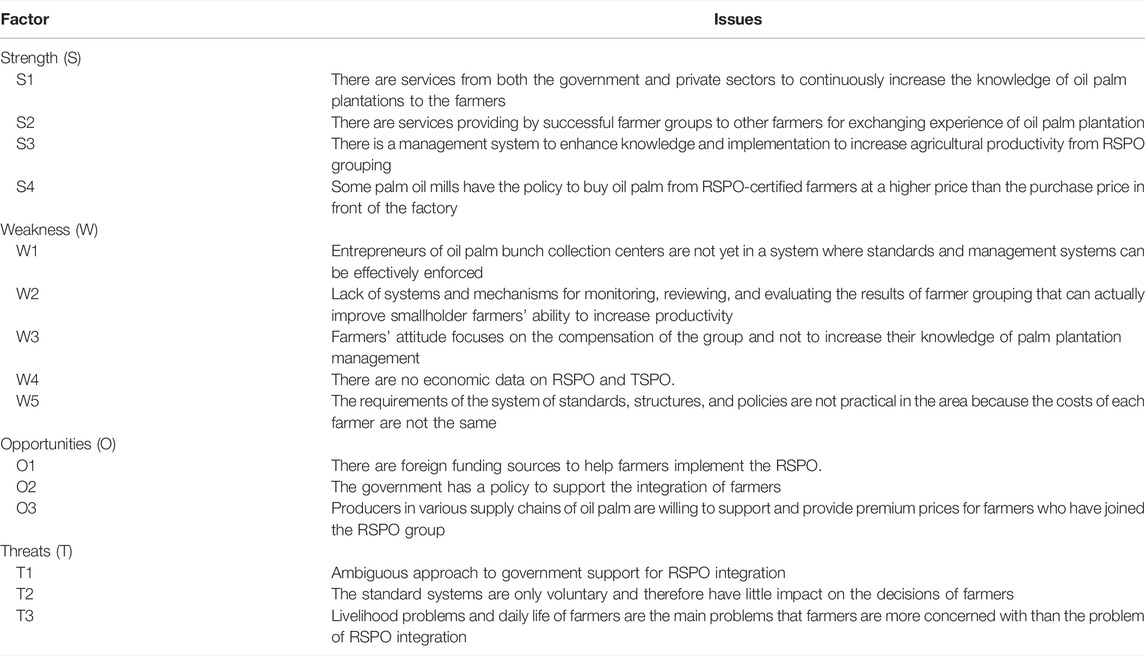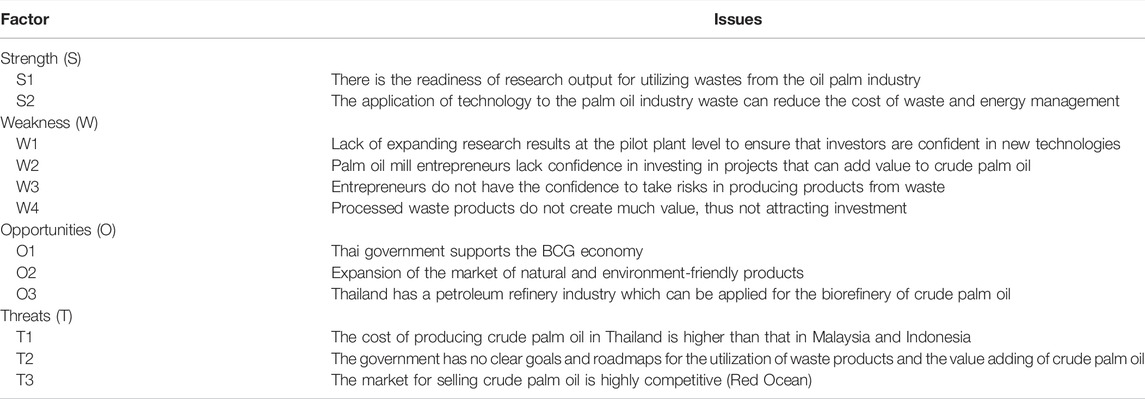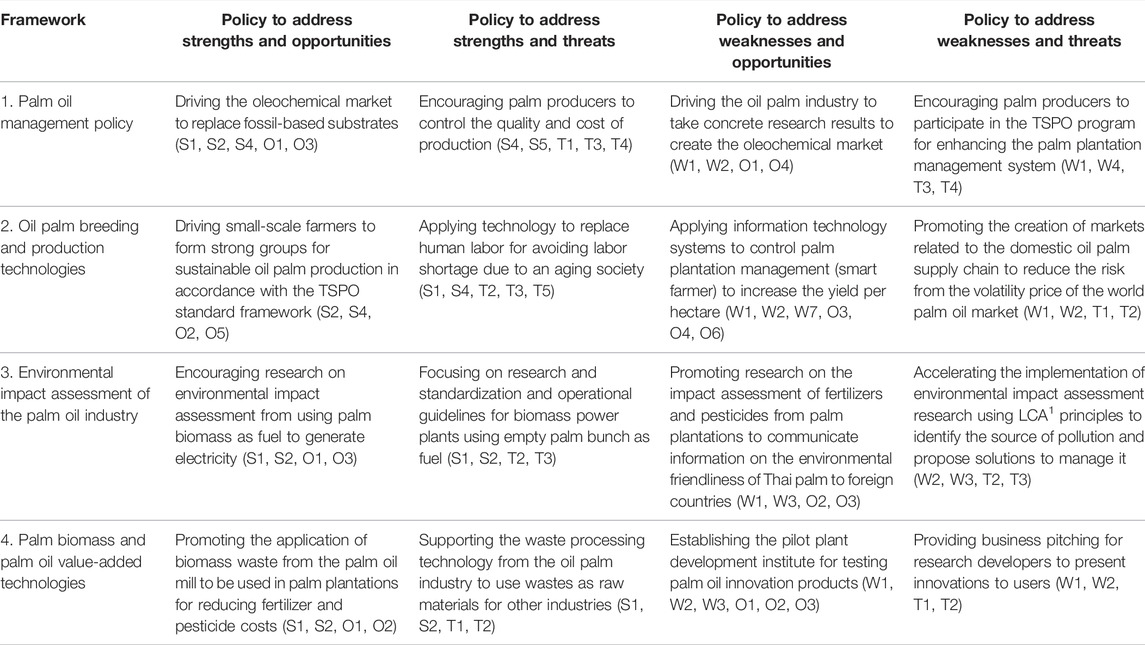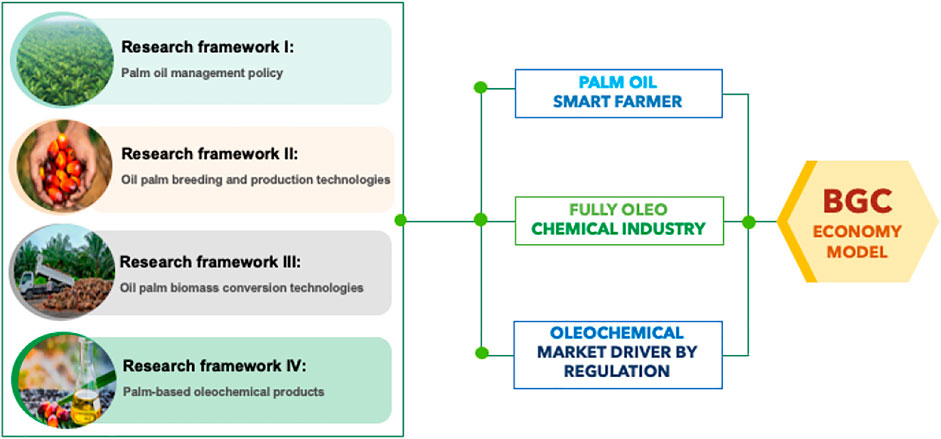Transition Pathway Palm Oil Research Framework Toward a Bio-Circular-Green Economy Model Using SWOT Analysis: A Case Study of Thailand
- 1Rattanakosin College for Sustainable Energy and Environment, Rajamangala University of Technology Rattanakosin, Nakhon Pathom, Thailand
- 2Environmental Research Institute, Chulalongkorn University, Bangkok, Thailand
- 3Department of Microbiology, Faculty of Science, Srinakharinwirot University, Bangkok, Thailand
- 4Agricultural Research Development Agency (Public Organization), Bangkok, Thailand
- 5Center of Excellence on Hazardous Substance Management (HSM), Chulalongkorn University, Bangkok, Thailand
- 6Department of Environmental Engineering, Faculty of Engineering, Chulalongkorn University, Bangkok, Thailand
Climate change, food security, and energy crisis are becoming more intense in our world. Oil palm can be utilized in both the food and biofuel industries. To respond to the crisis, it is necessary to develop palm oil products besides vegetable oil and biodiesel. This article focuses on the development of strategies to research oil palm throughout the supply chain in Thailand. The SWOT factors (the strengths, weaknesses, opportunities, and threats) are recognized via interviews with stakeholders. These stakeholders are feedstock producers, crude palm oil (CPO) producers, government agencies, biodiesel producers, palm oil refinery producers, and researchers. The results obtained from the data collection were analyzed and led to the formulation of strategies for future research on oil palm by the TOWS matrix. According to this analysis, future palm oil research framework strategies should consist of four categories: (1) oil palm management policy, developing regulation and economic instruments of various forms to systematically manage the oil palm industry, and applying big data and smart innovation to analyze market behavior; (2) oil palm breeding and production technologies, developing smart innovation in line with farmers’ lifestyles, and supporting research on oil content analysis and harvesting technology; (3) oil palm biomass conversion technologies, assessing environmental impacts through life cycle technology, evaluating the potential reduction of greenhouse gas emissions, and increasing the consumption rate of palm biomass; and (4) palm-based oleochemical products, developing oleochemical technology at the industrial level, expanding the potential capacity of producing oleochemical derivative products, and increasing the consumption rate and value added of CPO. All four frameworks were detailed and revised in line with the information obtained from seminars, comments, and interviews to meet the needs of all stakeholders. This framework will help drive the Bio-Circular-Green economy model in the future.
Introduction
The world faces global climate change and food and energy crises. The increase of food and energy prices affects commodity prices, threatening to exacerbate food insecurity in developing countries (Khoiruddin et al., 2021). Based on the climate risk index, Thailand is cited as one of the 10 most climate change-affected countries in the world (Eckstein et al., 2021).
Oil palm is relevant in both the food and biofuel industries. It is an important agro-industry on a global scale considering the increase in both production volumes and consumption rates (Hoffmann et al., 2017). As a country with suitable geography for palm plantations, Thailand continues to focus on developing its oil palm and related industries. The palm oil market in Thailand is 88% domestic, 2% exported, and 10–12% stocked. The domestic market is divided into three product categories: 35% food production, 45% biodiesel, and 20% other products (DIT, 2017).
The main energy supply in Thailand comes from six fuel types, such as oil (40.28%), natural gas (26.81%), biofuel and waste (19.99%), coal (11.96%), wind and solar (0.56%), and hydro (0.41%) (IEA, 2022). The trend of using bioenergy is continually increasing in response to government policies that support it. Palm oil plays an important role for blending in diesel fuel to produce biodiesel.
According to the resolution of the National Palm Oil Policy Committee of Thailand, the suitable crude palm oil stock level of Thailand should be 0.25 million tons (OAE, 2017). However, in 2018, Thailand’s crude palm oil stock was 0.47 million tons, which is well above the ideal level. Consequently, the average price of crude palm oil in Thailand fell from 24.9 baht per kilogram (0.72 USD/kilogram) in 2017 to 19.6 baht per kilogram (0.62 USD/kilogram) in 2018. The oversupply of crude palm oil prompted the Thai government to take measures to increase the consumption of crude palm oil.
To increase the rate of palm oil consumption, the Thai government set biodiesel B10 as the fundamental diesel oil at petrol stations to help absorb excess supplies of palm oil; however, biodiesel B7 and B20 are still allowed for older vehicles (Prasertsri and Chanikornpradit, 2021).
In addition, the government issued a measure to mix palm oil with bunker oil to generate electricity and boost palm oil prices (Raksaseri, 2021). However, these measures are short-term and have implications on the national budget. This is because the cost of using crude palm oil (CPO) as a power generation fuel is much higher than that of natural gas, which is the primary fuel for electricity generation in Thailand.
In contrast, Thailand recently faced high CPO prices due to the low production of vegetable oil in the world market and an increase in biodiesel production stemming from commitments from several governments, including Brazil, Germany, the United States, and Indonesia. It is expected that the CPO price in Thailand will reach 44 baht per kilogram (1.38 USD/kilogram), which is double of that in 2017. Volatility in CPO prices, which can cause uncertainty to a country’s overall economic growth, is an extremely important issue to be addressed (Dutta et al., 2021).
Besides the economic issues in the palm oil industry, the sustainability of the palm oil supply chain has been attended over the past 5 years. Rapid growth in demand for palm oil has led to high rates of deforestation and deeply inequitable socioeconomic circumstances (Bateman et al., 2022). Therefore, major users of palm oil are putting a lot of effort into raising the amount of sustainable palm oil they buy. The Roundtable on Sustainable Palm Oil (RSPO) is a nonprofit organization that was founded in 2004 with the goal of promoting the growth and usage of sustainable oil palm products by establishing reliable worldwide standards and engaging stakeholders. It is the most widely recognized certification standard for palm oil and its fractions in food and oleochemicals (EFECA, 2015). RSPO is organized into three impact areas: prosperity, people, and planet. There are seven principles distributed in each impact: (1) behave ethically and transparently; (2) operate legally and respect rights; (3) optimize productivity, efficiency, positive impacts, and resilience; (4) respect community and human rights and deliver benefits; (5) support smallholder inclusion; (6) respect workers’ rights and conditions; and (7) protect, conserve, and enhance ecosystems and the environment (RSPO, 2020). After RSPO was introduced in 2004, Malaysia and Indonesia launched their own scheme related to the sustainability of the palm oil industry.
The Malaysian Sustainable Palm Oil (MSPO) is the national scheme in Malaysia for oil palm plantations, independent and organized smallholdings, and palm oil processing facilities to be certified against the requirements of the MSPO Standards (MPOCC, 2022). The goals of MSPO are similar to those of RSPO, but it eliminated ineffective processes, particularly in the legal area, which is regulated separately in Malaysian law (Mansor et al., 2016).
The Indonesian Sustainable Palm Oil (ISPO) was founded in 2011 to ensure that all Indonesian oil palm growers adhere to higher agricultural standards. Its purpose is to improve the long-term viability and competitiveness of the Indonesian palm oil industry while also ensuring the production’s sustainability, particularly in the prevention of palm oil-related problems (Hidayat et al., 2018). ISPO requires all oil palm growers in Indonesia, from large plantation businesses to smallholders, to follow the standard. It is a mandatory scheme in Indonesia (Astari and Lovett, 2019). Seven principles of the ISPO are (1) licensing system and plantation management, (2) the application of technical guidelines for palm oil cultivation and processing, (3) environmental management and monitoring of oil palm plantation, (4) responsibilities for workers, (5) social and community responsibility, (6) strengthening community economic activities, and (7) sustainable business development (Umayah et al., 2021).
Thailand also tries to launch its own model related to palm oil sustainable consumption in the scheme of Thailand Sustainable Palm Oil (TSPO); however, it has not yet been officially announced. From the foregoing, it can be seen that the palm industry is under pressure both economically and environmentally.
For these reasons, policies related to diversifying palm oil consumption should be generated to discover new ways of utilizing palm oil products to balance supply and demand in the palm oil industry. The Bio-Circular-Green economy model (BCG economy model) has been introduced by the research community and promoted by the Thai government to transform a new economic model for inclusive and sustainable growth, in line with the UN Sustainable Development Goals (SDGs) (Naksomsong and Pongsupatt, 2021). The model focus on four sectors, namely, 1) food and agriculture, 2) medical and wellness; 3) bioenergy, biomaterial, and biochemical; and 4) tourism and creative economy (NXPO, 2020). The BCG model is different from other concepts because this model proposes the development of bioeconomy, circular economy, and green economy simultaneously to drive Thailand’s economy in a concrete manner. This model will play an important role to transform Thailand into a value-based and innovation-driven economy that can come out of the middle-income trap (Meiksin, 2020). Utilizing biodiversity and cultural diversity as a basis for developing the nation and improving people’s quality of life is also the main concept of this model. Many previous works focus on the one-by-one concept, while the BCG model integrated all three main concepts to drive the sustainable economy of the country.
Several studies have focused on how biodiesel policies related to palm oil consumption impact the environment. Permpool et al. (2016) revealed that about 91,200 ha of additional land was needed for the oil palm plantation for AEDP targets of 2021 for biodiesel. This will lead to an annual greenhouse gas (GHG) saving amount of 115,882 tCO2-eq. The East and South were identified as the most potential regions. Chanthawong and Dhakal (2016) investigated the stakeholders’ perceptions of biodiesel and bioethanol policy using SWOT-AHP-TOWS analysis. They found that government policy and regulation are the key important factors to manage the price of biofuel; in addition, balancing the positive and negative impacts among economic, environmental, and social issues should be concerned. Lecksiwilai and Gheewala (2020) use life cycle assessment (LCA) to evaluate the environmental trade-offs of biofuels in Thailand. They indicated that biofuels have lower impacts than fossil fuels when determining only GHG, while it became worse than fossil fuels when pesticides and land impacts were included. To prevent problems shifting from some impacts to other impacts, all environmental impacts should be concerns. During policy formulation or selection of potential mitigation measures, it is recommended to apply LCA as a tool for decision-making. Siangjaeo et al. (2011) study on the GHG emission of land-use change from palm biodiesel production in Thailand. They indicated that the land-use change shows a negative GHG balance in all scenarios. Therefore, biodiesel helps to reduce GHG. However, they suggested that appropriate data on fertilizer production and application should be considered for further study as there are data limitations in Thailand.
Other studies have focused on policy decision-making pertaining to palm oil production sustainability. Jamaludin et al. (2018) developed a palm oil mill sustainability index to assess the sustainability performance of palm oil mills against benchmarks. Jensen et al. (2019) proposed an innovative fully integrated Macroeconomic-Environmental-Demographic-health (MED-health) in Thailand, which indicated that the food policy research should include both food and non-food policy indicators. Saswattecha et al. (2017) reported that the environmental sustainability of Thai palm oil production could not avoid future impacts if applying only cost-effective options. A novel integrated decision model for determining biodiversity losses was studied by Tapia and Samsatli (2020). However, there are no studies on the development of research strategies on palm oil throughout the supply chain. This is particularly important for developing countries to compete in the global palm market.
To fill this gap in the literature, this study investigates how palm oil research strategies throughout the supply chain in Thailand can be improved using SWOT (strengths, weaknesses, opportunities, and threats) analysis and TOWS matrix methodologies. The objectives of this study were to (1) identify the weaknesses, strengths, opportunities, and threats of the research framework of palm oil in Thailand that are relevant for the transition to the BCG economy model and (2) propose strategies to develop a research framework on palm oil in the transition to a sustainable, circular bioeconomy.
Theoretical Framework
Palm Oil Research Framework
In this study, we focused on the research framework supported by the Agricultural Research Development Agency (ARDA), which is a public organization. ARDA is under the supervision of the Ministry of Agriculture and Cooperatives, which has the mission of promoting, supporting, and developing agricultural research and information (ARDA, 2018). Palm oil is an important agricultural product in Thailand. Between 2013 and 2017, ARDA supported 140 research projects relevant to the palm oil supply chain, which were divided into four frameworks: (1) palm oil management policy, (2) oil palm breeding and production technologies, (3) environmental impact assessment of the palm oil industry, and (4) palm biomass and palm oil value-added technologies. To improve palm oil research strategies throughout the supply chain in Thailand, each framework was analyzed to identify a problem in the palm oil supply chain that has not been answered by any of the existing research.
Strengths, Weaknesses, Opportunities, and Threats Analysis and TOWS Matrix
Improvement is an inevitable part of policy planning. Identifying the relevant strengths, weaknesses, opportunities, and threats is conducive to more efficient policy planning and action. In the area of policy planning, SWOT analysis has been recently used to (i) find strategies toward a sustainable forest-based bioeconomy in Italy (Falcone et al., 2020), (ii) formulate solutions for edible oil waste from farm to table in Iran (Salmani et al., 2021), and (iii) study the utilization of forest residues as biomass in Turkey (Kurt, 2020).
There are three primary steps to creating a SWOT analysis: (1) gather all currently available information on the strengths and weaknesses of the existing situation, including pertinent data. All information was gathered through (1) interviews and brainstorming sessions; (2) identifying all potential opportunities and threats to the development of the research framework, including future trends and technology; and (3) prioritizing each aspect in each of the four categories in the SWOT matrix. In addition, the TOWS matrix is used in this study to generate a strategy. The TOWS matrix improves the systemic deployment of strategies by considering the relationships between strengths, weaknesses, opportunities, and threats. A matrix called the TOWS matrix can be used to replace the effects of internal and external influences. The TOWS matrix aids in the methodical identification of links between threats, opportunities, weaknesses, and strengths and also provides a framework for developing strategies based on these relationships (Aslan et al., 2012).
SWOT and TOWS are different in that SWOT focuses on the internal environment (strengths and weaknesses), whereas a TOWS matrix focuses on the external environment (opportunities and threats). To achieve the objectives of this study, SWOT and the TOWS matrix were used to examine the internal (i.e., strengths and weaknesses) and external factors (opportunities and threats) in each framework to develop the proposed strategies.
Methods and Data
The research methodology used in this study consists of an in-depth literature review and a SWOT analysis. The details of each section can be described as follows.
In-Depth Literature Review to Identify the Research Gap
To understand the status of the palm oil research framework funded by ARDA, we reviewed 140 research projects supported by ARDA from 2013–2017. For each project, we constructed a matrix of stakeholders of the palm oil value chain to identify the user in each project. Users were divided into four categories: (1) farmers, (2) palm oil mills, (3) palm oil refineries and biodiesel, and (4) oleochemical industry. Then, in each framework, we analyzed the research gap to propose the recommendation for improving the research framework.
Strengths, Weaknesses, Opportunities, and Threats Analysis
To collect data identifying the relevant SWOT factors for each category, the respondents were interviewed using open-ended questionnaires (Survey I). The example of questionnaires can be found in Supplementary Appendix SA. To guide policy development, perceptions were collected via snowball sampling from six stakeholder groups: (1) feedstock producers, (2) crude palm oil producers, (3) government agencies, (4) biodiesel producers, (5) palm oil refinery producers, and (6) researchers. The list of participants was gathered from personal contacts; the RSPO global membership list; a database of researchers from ARDA; journal publications; the Thai Biodiesel Producer Association; and contacts at palm oil mills, palm oil refineries, and oleochemical plants in Thailand.
The sample groups were selected by snowball random sampling (Etikan et al., 2016), which was stopped when the collected data were sufficient to conclude the result of SWOT factors. The questionnaires asked respondents to think about the factors that could encourage or discourage the commercialization of research results and suggestions for future research guidelines for the development of palm oil supply chains. Suitable response questionnaires were received and analyzed in a more concise and manageable SWOT table. The sample sizes in each group of stakeholders are shown in Figure 1.
In Survey II, the respondents were invited to participate in the seminar focus group, and open-ended questionnaires were sent to individuals to discuss and prioritize the SWOT factors. The next step of SWOT is a TOWS matrix to develop strategies based on the relationships between threats, opportunities, weaknesses, and strengths identified from the SWOT analysis (Aslan and Bozkurt, 2010). The strategies obtained from the TOWS matrix can be divided into four categories (Chanthawong and Dhakal, 2016):
1) WT Strategy (Min-Min) – this strategy employs to minimize both weaknesses and threats.
2) WO Strategy (Min-Max) – this strategy attempts to minimize the weaknesses and use chances from the external environment.
3) ST Strategy (Max-Min) – this strategy employs the strengths to deal with threats from the environment.
4) SO Strategy (Max-Max) – this strategy aims to use both strengths and opportunities for taking advantage of chances.
The respondents were asked to discuss and formulate strategies in this section. The first draft of the palm oil research framework strategy was validated by experts in the field (Survey III). The SWOT matrix was checked by means of two interviews with experts affiliated with the Agricultural Research Development Agency and the Office of Agricultural Economics. The interviews were conducted from June to July 2020. This process led to an improved version of the SWOT analysis and a refinement of the identified strategies. An overview of the methodology of this study is shown in Figure 2.
After applying the proposed framework, there are ways to evaluate the outcome and impact as follows: (1) Outcome: the evaluation of the proposed framework outcome can be tracked by academic results, for example, the number of article publications related to the issue contained in the proposed framework and the number of patents. In the case of technology outcome, it should be evaluated in terms of the number of new products and technology sales revenue; (2) Impact: the evaluation of the impact is based on the effect of research results in a wide range for the economy, society, and environment. Gross domestic product (GDP) and upgrading the quality of life are the example criteria for evaluating the impact of the research framework.
Results and Discussion
Strengths, Weaknesses, Opportunities, and Threats Analysis
In this study, the representatives of six stakeholder groups were selected, and invitation letters were sent to representatives to participate in the SWOT survey and in-depth interviews.
The results of the SWOT survey show that 77% of respondents perceived the clear structure of the palm oil industry and understood that the Thailand Oil Palm Board supervises and sets appropriate policy guidelines. The wide range of expertise for researchers and policymakers was a strength of palm oil management policy in Thailand. Likewise, 83% of respondents perceived that the lack of research output to develop policy frameworks, integrating policy knowledge for relevant personnel with specific expertise, and applying data science in policy research were the weaknesses. In the case of opportunities, 67% of respondents perceived that policy support from the government (e.g., pushing the oleochemical industry to replace raw materials in the petrochemical industry and using palm oil as an energy source in biodiesel) was the opportunity. Last, 82% of respondents perceived the difficulty of controlling small- and medium-sized palm producers, reducing biodiesel consumption stemming from policies promoting electric vehicles, and fluctuating global crude palm oil prices as threats. The results are shown in Table 1.
Table 2 shows the SWOT analysis of oil palm breeding and production technologies. Up to 81% of respondents perceived that farmers’ willingness to support research projects, a strong group of palm producers, the Thai climate, and an environment suitable for developing palm species were strengths. Meanwhile, 80% of respondents perceived that a lack of purchasers’ awareness of improper palm plantation, high fertilizer and labor costs, and a lack of palm species and palm plantation management knowledge were weaknesses. For opportunities, 74% of respondents perceived that the increasing trend of sustainability standards for consumer products, lower prices of palm oil, and the need for technology to analyze palm oil were opportunities. Last, 70% of respondents perceived that unanticipated and poorly planned government actions, fluctuations in price and volume of palm oil, and the aging society in Thailand were threats.
As shown in Table 3, 67% of respondents perceived the palm oil database of GHG emissions, palm oil entrepreneurs being in the hotspot of energy and emissions, and the efficiency of treating wastewater systems in Thailand as strengths. On the other hand, 65% of respondents perceived that the lack of research projects tackling problems in the oil palm industry, the lack of applicable research output to the oil palm industry, and the lack of LCA research on fertilizers and pesticides were weaknesses. Similarly, 65% of respondents perceived that government policy on using palm biomass as fuel for power plants and palm plantations certified by RSPO were opportunities. Last, 69% of respondents perceived that the trends of stricter EU renewable energy legislation, environmental conservation, and reducing consumption of saturated fats were threats.
Strength factors, such as government and private sector services, increase the knowledge of oil palm plantations to farmers, and the exchange experience between successful farmer groups and other farmers was perceived by 80% of respondents, as shown in Table 4. For weakness factors, ineffective enforcement regulations for palm oil bunch collection centers and the lack of a monitoring system for improving farmers’ ability were perceived as weakness factors by 53% of respondents. For opportunities, 67% of respondents perceived that foreign funding sources, government policy, and producers in the supply chain giving premium prices for RSPO products were opportunities. On the other hand, 88% of respondents perceived that the ambiguous policy approach on RSPO and the voluntary standard of palm oil sustainable programs were threats.
Table 5 shows the SWOT analysis of palm biomass and palm oil value-added technologies. Up to 58% of respondents perceived that research output was sufficient for utilizing waste from the oil palm industry, waste utilization technology for the palm oil industry reducing the cost of waste management, and energy management were strengths. Regarding weaknesses, 69% of respondents perceived that the lack of pilot-scale technology and the lack of entrepreneurs’ confidence were weaknesses. BCG economy policy and the expanding market of environment-friendly products were perceived by 58% of respondents as the opportunity. Similarly, 58% of respondents perceived that the higher cost of producing CPO and the vague roadmaps of utilizing palm biomass wastes were the threats.
Policy Implications of Strengths, Weaknesses, Opportunities, and Threats Analysis Using the TOWS Matrix
Possible policies to develop oil palm and palm oil research throughout the supply chain in Thailand are shown in Table 6. Strategies (SO, ST, WO, and WT) are suggested in potential areas of policy development. Each strategy was formulated by pooling between the high-scoring factors in the SWOT category.
Palm Oil Management Policy
1) Driving the oleochemical market to replace fossil-based substrates (SO strategy): The potential long-term measures in this strategy may include reducing taxation for businesses in the oleochemical industry and providing financial incentives to support investment and production of oleochemical products in the palm oil supply chain. Governments should raise long-term awareness of using products that promote a green economy and focus on job creation and economic growth while minimizing environmental impact. Using oleochemical products to replace fossil-derived products will reduce the overall GHG emissions of the country and reduce the loss of income from the import of petroleum products from abroad (Chin et al., 2021).
2) Encouraging palm oil producers to control the quality and cost of production (ST strategy): Measures in this strategy are enhancing yield per hectare, a palm plantation management system, efficient use of fertilizers, and controlling weed and plant diseases. Reducing the cost of palm plantation management will increase the competitiveness of palm producers (Munasinghe et al., 2019). The reduction of transportation costs is an important part of the palm oil industry. In addition, contact farming is another process that allows farmers to trade directly with industrial plants, which can reduce the problem of middlemen.
3) Driving the oil palm industry to take concrete research results in creating the oleochemical market (WO strategy). This strategy will encourage the oil palm and palm oil industry to apply the research results at the industrial level to produce new products with a higher value and greater environmental friendliness (Syarifudin and Zareen, 2021). Measures may include providing the flexibility of research licenses to the industry that can be used for trial production and cost-effectiveness considerations. In addition, the transfer of knowledge from researchers to the industrial sector should be encouraged in a more concrete manner.
Oil Palm Breeding and Production Technologies
1) Driving small-scale farmers to form strong groups for sustainable oil palm production (SO strategy): More than 80% of the total area under oil palm production is cultivated by small-scale farmers or smallholders who have limited knowledge of sustainable farming practices (e.g., applying organic material and optimizing fertilizer use) (Saswattecha, 2019). Therefore, the Thai government should expand sustainable palm oil production rapidly through certification of an entire jurisdiction. Measures that may be included in this strategy are creating qualified national instructors, enhancing oil palm smallholders’ capacities in sustainable farming practices, and promoting cooperation along the value chain for smallholder engagement to increase awareness of sustainable palm oil in Thailand.
2) Applying technology to replace human labor to avoid labor shortages due to an aging society and the pandemic COVID-19 virus (ST strategy): Currently, it is very difficult to find the labor for palm plantations, and most of the plantation workforce are migrant workers. In addition, the COVID-19 pandemic is further exacerbating the situation due to the national lockdown. The shortage of oil palm harvesters will affect the oil palm yields and the cost of palm oil plantations. Using harvesting technology, for example, data gathered by ICT for providing real-time operations and forecasting and enhancing workers’ productivity by applying new technologies (Rahim et al., 2011), can be a measure of this strategy.
3) Information technology systems should be applied to control palm plantation management or smart palm plantation management to increase yield per hectare (WO strategy). Unmanned aerial vehicles (UAVs) can be the option for this strategy. It can carry out observations of individual palms and can operate unnoticed and under cloud cover (Zheng et al., 2021). UAV technology can be adapted for oil palm plantations, for example, yield mapping and monitoring, using thermal cameras for automated airborne pest monitoring, and using very high-resolution optical images for identifying and counting specific insects (Shamshiri et al., 2018). Other recommendations are as follows: (1) integration of localized Internet of Things (IoT) devices to monitor moisture and nutrients in soil properties, (2) optimization of harvesting plans and routes by detecting ripped fruit and cloud computing with IoT devices, and (3) forecasting fresh palm fruit generation using IoT and big data analysis (Lim et al., 2021).
4) Promoting the creation of markets related to the domestic oil palm supply chain to reduce the risk from the volatility price of the world palm oil market (WT strategy): Palm fruit and CPO price variabilities have become a serious problem for palm oil producers in Thailand (Mukherjee and Sovacool, 2014). The government comes up with measures to intervene in the market price to help prop up prices from time to time. In this situation, the creation of a market of multiple products from the oil palm supply chain can relieve the risk of price volatility. The palm biomass market should be encouraged because its characteristics can be converted to multiple products (energy, chemicals, and materials) (Abdulrazik et al., 2017). In addition, the demand for oleochemical products, such as pharmaceuticals, cosmetics, and industrial chemicals, is expected to increase by 5.1% annually in the Asia-Pacific region (Elsevier, 2015; Khatiwada et al., 2021). Therefore, measures to create an oleochemical market were suggested.
Environmental Impact Assessment of the Palm Oil Industry
1) Encouraging research on environmental impact assessment from using palm biomass as fuel to generate electricity (SO strategy): It is already known that palm biomass has the potential as a fuel for producing electricity to operate in a mill or sell to the grid. Therefore, the data on environmental impacts should be prepared to create awareness and the prevention of that activity. LCA research on palm biomass should be a measure to operate under various technologies for comparison (Anyaoha and Zhang, 2021; Siregar et al., 2021).
2) Focusing on research and standardization, operational guidelines for biomass power plants using empty palm bunches as fuel (ST strategy): Biomass power plants using empty palm bunches as fuel are gaining popularity, although operational guidelines are unclear. In Thailand, there are four technologies for converting biomass to energy: direct-fired, co-firing, gasification, and pyrolysis technology. Therefore, it is necessary to have research related to standardization for the operation of those power plants. The measures included in this strategy formulate guidelines for the surveillance of areas at the risk of air pollution from palm biomass power plants and the standard for the quality and price of biomass pellets (Salleh et al., 2018).
3) Promoting research on the impact assessment of fertilizers and pesticides from palm plantations to communicate information on the environmental friendliness of Thai palm to foreign countries (WO strategy): The hotspot of environmental loads for producing the final products of the oil palm supply chain was the agricultural stage and milling stage, approximately 81–92% of the overall environmental loads (Phuang et al., 2021). To increase the competitiveness of Thai palm growers, the optimal level of chemical fertilizer, pesticide, and herbicide use should be evaluated. It not only helps oil palm producers to understand the environmental impact of overuse of fertilizers and pesticides but also helps oil palm producers to reduce production costs.
4) Accelerating the implementation of environmental impact assessment research using LCA principles to identify the sources of pollution and propose solutions to manage it (WT strategy): To avoid environmental pollution and create a suitable strategy for waste management in the palm oil industry, the green approach with less environmental impact should be selected by LCA as a tool for decision-making and management. The application of LCA with palm oil extraction and refinement, including the oleochemical process, should be an important measure (Ghazali et al., 2021).
Palm Biomass and Palm Oil Value-Added Technologies
1) Promoting the application of biomass waste from palm oil mills is used in palm plantations to reduce fertilizer and pesticide costs (SO strategy): It is well known that only 20% of 1 ton of a fresh fruit bunch of oil palm can be extracted to produce palm oil, and the rest is biomass and water. Repurposing palm biomass, which has various applications, on palm oil plantations should be a part of this strategy. For example, palm oil empty fruit bunches and palm oil mill sludge can be used to produce organic fertilizers (Hisham and Ramli, 2021; Sudradjat and Diansyah, 2021). Palm oil mill sludge can also be used to enhance the growth and vigor of oil palm seedlings during the nursery stage (Ramachandrudu, 2020). The ash of oil palm empty fruit bunches can be used as a source of potassium for producing NPK fertilizers (Arfiana et al., 2021).
2) Waste processing technology from the oil palm industry should be used to utilize wastes as raw materials for other industries (ST strategy). Various technologies have been applied with different waste types to convert solid biomass waste and palm oil mill effluent (POME) into bioenergy and valuable products (Al-samet et al., 2021), such as dried long fiber for matting, pallets, briquettes, biofertilizer, and biofuels. Commercializing this technology will lead to zero waste in the palm oil industry (Harun et al., 2022). The government should support the recycling business using tax incentives and flexible regulation of palm oil industrial waste, which are important components of this strategy.
3) Establishing the pilot plant development institute for testing palm oil innovation products (WO strategy): The major barrier for transferring research products to commercialization is the risk of scaling the production line from the laboratory level to the industrial level. Therefore, it is necessary to test the research product at a pilot scale to collect data and adjust the problems before investing in the industry as experiments at the pilot plant level require a relatively high level of investment. The government should establish an institute that performs this function for the palm oil industry, which will promote and expand more research outputs to industrial sectors.
4) Providing business pitching for researchers to present innovations to users (WT strategy): Research outputs of utilizing palm biomass have the potential to scale up for commercialization; however, matching with investors is still lacking. Malaysia is a good role model for establishing innovation pitches and business matching (Ismail, 2019). This event will facilitate research output matching with investors, which will lead to the emergence of new businesses in the palm oil industry.
Conclusion and Policy Implication
In the current study, we have used the SWOT-TOWS matrix to analyze stakeholders’ perspectives and provide ideas for further policy development on the future research framework palm oil supply chain in Thailand. The findings from in-depth interviews and semi-structured questionnaires in this study showed the strengths, weaknesses, opportunities, and threats of each research framework. This study also provides potential strategies for the future research framework palm oil supply chain in Thailand suggested through the stakeholder analysis.
All issues above provide new ideas and address shortcomings of the current market and policies to promote palm oil development. To fill the gap in the literature and develop a sustainable palm oil industry, a future research framework palm oil supply chain in Thailand was proposed, as shown in Figure 3.
This framework consisted of four categories: (1) palm oil management policy, developing regulation and economic instruments of various forms to systematically manage the oil palm industry, and applying big data and smart innovation to analyze market behavior; (2) oil palm breeding and production technologies, developing smart innovation in line with farmers’ lifestyles, and supporting research on oil content analysis and harvesting technology; (3) oil palm biomass conversion technologies, assessing environmental impacts through life cycle technology, evaluating the potential reduction of GHG emissions, and increasing the consumption rate of palm biomass; and (4) palm-based oleochemical products, developing oleochemical technology at the industrial level, expanding the potential capacity of producing oleochemical derivative products, and increasing the consumption rate and value added of CPO. Palm-based oleochemical products are a new category in this framework that will be an important complement to a truly integrated palm oil industry and can help stabilize the industry’s supply and demand. The framework will be operated through three main strategies: 1) palm oil smart farmer, 2) fully oleochemical industry, and 3) oleochemical market driven by regulation. Finally, this framework will help drive the BCG economy model in the future. Although we have good strategies to increase the value of palm oil and promote sustainable palm oil production throughout the supply chain, the adoption and flexibility of palm oil policies are still crucial to maintaining a balance between food and energy. External factors are important variables for considering oil palm policy actions, for example, war, climate changes, and disease outbreaks. Supporting sustainable palm oil can reduce deforestation. Although Thailand has not dominated in this problem as most of the palm plantation area comes from wasteland and agricultural land, the adoption of responsible practices to small-scale farmers can make it possible for them to receive global certification (i.e., RSPO certification), which will gain opportunities to access international markets.
The study on social sciences or policy study is normally hard to reproduce the results but does not mean those studies were wrong, except it kind of does. Due to the fact that many factors cannot be completely controlled (for example, the economic situation, the mindset of respondents, the existing problem of the palm oil supply chain, location, and others), the result of experiments can be different when the experiment is replicated. The result of policy research is dynamic; especially, it depends on the time intervals of the study. However, readers will benefit from the researcher’s point of view on resolving the situation at that time and can use it as a guideline to develop better solutions in the future.
Data Availability Statement
On request to the corresponding author, the datasets generated for this work are available.
Author Contributions
PU: methodology, investigation, conceptualization, writing—original draft, and writing—review and editing; NT: methodology, investigation, and SWOT analysis; PP: investigation and SWOT analysis; PV: conceptualization and supervision; CS: conceptualization, resources, and supervision. OC: resources, interpretation, and supervision.
Funding
The Agricultural Research Development Agency (Public Organization) of Thailand (grant no. POP6205031550).
Conflict of Interest
The authors declare that the research was conducted in the absence of any commercial or financial relationships that could be construed as a potential conflict of interest.
Publisher’s Note
All claims expressed in this article are solely those of the authors and do not necessarily represent those of their affiliated organizations or those of the publisher, the editors, and the reviewers. Any product that may be evaluated in this article or claim that may be made by its manufacturer is not guaranteed or endorsed by the publisher.
Acknowledgments
The authors would like to thank the Agricultural Research Development Agency of Thailand for funding this project. In addition, the authors would like to thank the Rattanakosin College for Sustainable Energy and Environment (RCSEE) at Rajamangala University of Technology Rattanakosin for supporting this research.
Supplementary Material
The Supplementary Material for this article can be found online at: https://www.frontiersin.org/articles/10.3389/fenvs.2022.877329/full#supplementary-material
Footnotes
1Detailed explanation of life cycle assessment (LCA) can be found in Graedel et al. (1998). Streamlined Life-cycle Assessment. Prentice Hall. https://books.google.co.th/books?id=YEViQgAACAAJ
References
Abdulrazik, A., Elsholkami, M., Elkamel, A., and Simon, L. (2017). Multi-products Productions from Malaysian Oil Palm Empty Fruit Bunch (EFB): Analyzing Economic Potentials from the Optimal Biomass Supply Chain. J. Clean. Prod. 168, 131–148. doi:10.1016/j.jclepro.2017.08.088
Al-samet, M. A., Goto, M., Mubarak, N. M., and Al-Muraisy, S. A. (2021). Evaluating the Biomethane Potential from the Anaerobic Co-digestion of Palm Oil Mill Effluent, Food Waste, and Sewage Sludge in Malaysia. Environ. Sci. Pollut. Res. 28 (47), 67632–67645. doi:10.1007/s11356-021-15287-2
Anyaoha, K. E., and Zhang, L. (2021). Renewable Energy for Environmental Protection: Life Cycle Inventory of Nigeria's Palm Oil Production. Resour. Conservation Recycl. 174, 105797. doi:10.1016/j.resconrec.2021.105797
ARDA (2018). About ARDA. Bangkok, Thailand: Agricultural Research Development Agency. (Public Organization) Retrieved January 10 from: https://www.arda.or.th/en/about.php.
Arfiana, , Finalis, E. R., Noor, I., Sumbogo Murti, S. D., Suratno, H., Rosyadi, E., et al. (2021). Oil Palm Empty Fruit Bunch Ash as a Potassium Source in the Synthesis of NPK Fertilizer. IOP Conf. Ser. Earth Environ. Sci. 749, 012038. doi:10.1088/1755-1315/749/1/012038
Aslan, I., and Bozkurt, R. (2010). “Strategic Sustainable Development and Creating Strategies from TOWS Matrix at Kipas Group,” in Proceeding of the 2nd International Symposium on Sustainable Development, Sarajevo, August 2010.
Aslan, I., Çınar, O., and Kumpikaitė, V. (2012). Creating Strategies from Tows Matrix for Strategic Sustainable Development of Kipaş Group/Darnaus Vystymosi Kipas Grupėje Strategijų Kūrimas Remiantis Ggss Matrica. J. Bus. Econ. Manag. 13 (1), 95–110. doi:10.3846/16111699.2011.620134
Astari, A. J., and Lovett, J. C. (2019). Does the Rise of Transnational Governance 'hollow-Out' the State? Discourse Analysis of the Mandatory Indonesian Sustainable Palm Oil Policy. World Dev. 117, 1–12. doi:10.1016/j.worlddev.2018.12.012
Bateman, A., Sheff, Y., Lee, Y. J., and Ata, A. (2022). Towards Sustainable Palm Oil. the MIT Center for Transportation and Logistics. Retrieved April 24 from: https://sustainable.mit.edu/towards-sustainable-palm-oil/.
Chanthawong, A., and Dhakal, S. (2016). Stakeholders' Perceptions on Challenges and Opportunities for Biodiesel and Bioethanol Policy Development in Thailand. Energy Policy 91, 189–206. doi:10.1016/j.enpol.2016.01.008
Chin, S. Y., Shahruddin, S., Chua, G. K., Samsodin, N., Setiabudi, H. D., Karam Chand, N. S., et al. (2021). Palm Oil-Based Chemicals for Sustainable Development of Petrochemical Industries in Malaysia: Progress, Prospect, and Challenges. ACS Sustain. Chem. Eng. 9 (19), 6510–6533. doi:10.1021/acssuschemeng.0c09329
DIT (2017). Thailand Domestic Crude Palm Oil Market. Available from: https://www.krungsri.com/bank/getmedia/70f0c5ae-fa59-4117-812e-78a8cbcd24cc/IO_Oil_Palm_2018_EN.aspx.
Dutta, A., Bouri, E., Saeed, T., and Vinh Vo, X. (2021). Crude Oil Volatility and the Biodiesel Feedstock Market in Malaysia during the 2014 Oil Price Decline and the COVID-19 Outbreak. Fuel 292, 120221. doi:10.1016/j.fuel.2021.120221
Eckstein, D., Kunzel, V., and Schafer, L. (2021). Global Climate Risk Index 2021. Berlin, Gernamy: Germanwatch e.V.
EFECA (2015). Comparison of the ISPO, MSPO and RSPO. Bournemouth, United Kingdom: E. F. A. Ltd. Available from: http://www.efeca.com/wp-content/uploads/2016/03/Efeca_PO-Standards-Comparison-.pdf.
Elsevier, (2015). Rising Demand in Cosmetics Applications Drives Oleochemicals Market. Elsevier. Available from: https://www.sciencedirect.com/journal/focus-on-surfactants/vol/2015/issue/4.
Etikan, I., Alkassim, R., and Abubakar, S. (2016). Comparision of Snowball Sampling and Sequential Sampling Technique. Biometrics Biostat. Int. J. 3 (1), 55. doi:10.15406/bbij.2016.03.00055
Falcone, P. M., Tani, A., Tartiu, V. E., and Imbriani, C. (2020). Towards a Sustainable Forest-Based Bioeconomy in Italy: Findings from a SWOT Analysis. For. Policy Econ. 110, 101910. doi:10.1016/j.forpol.2019.04.014
Ghazali, R., Ishak, S. A., Zolkarnain, N., and Ishak, S. A. (2021). Palm-based Oleochemicals in Non-food Applications: Meeting the Environmental Regulatory Challenges. ASM Sci. J. 16, 1–10. doi:10.32802/asmscj.2021.679
Graedel, T. E., Laboratories, T. B., and Innovations, B. L. (1998). Streamlined Life-Cycle Assessment. New Jersey, NJ: Prentice-Hall. Available from: https://books.google.co.th/books?id=YEViQgAACAAJ.
Harun, S., Luthfi, A. A. I., Abdul, P. M., Bukhari, N. A., and Jahim, J. M. (2022). “Oil Palm Biomass Zero-Waste Conversion to Bio-Succinic Acid,” in Value-Chain of Biofuels. Editors S. Yusup, and N. A. Rashidi (Elsevier), 249–275. doi:10.1016/B978-0-12-824388-6.00011-7
Hidayat, N. K., Offermans, A., and Glasbergen, P. (2018). Sustainable Palm Oil as a Public Responsibility? on the Governance Capacity of Indonesian Standard for Sustainable Palm Oil (ISPO). Agric. Hum. Values 35 (1), 223–242. doi:10.1007/s10460-017-9816-6
Hisham, N. E. B., and Ramli, N. H. (2021). Incorporation of Rice Husk Ash with Palm Oil Mill Wastes in Enhancing Physicochemical Properties of the Compost. J. Trop. Agric. Sci. 44 (1), 221–236. doi:10.47836/PJTAS.44.1.13
Hoffmann, M. P., Donough, C. R., Cook, S. E., Fisher, M. J., Lim, C. H., Lim, Y. L., et al. (2017). Yield Gap Analysis in Oil Palm: Framework Development and Application in Commercial Operations in Southeast Asia. Agric. Syst. 151, 12–19. doi:10.1016/j.agsy.2016.11.005
IEA (2022). Total Energy Supply (TES) by Source, Thailand 1990-2019. Paris, France: International Energy Agency. Retrieved May 7 from https://www.iea.org/countries/thailand.
Jamaludin, N. F., Hashim, H., Muis, Z. A., Zakaria, Z. Y., Jusoh, M., Yunus, A., et al. (2018). A Sustainability Performance Assessment Framework for Palm Oil Mills. J. Clean. Prod. 174, 1679–1693. doi:10.1016/j.jclepro.2017.11.028
Jensen, H. T., Keogh-Brown, M. R., Shankar, B., Aekplakorn, W., Basu, S., Cuevas, S., et al. (2019). Palm Oil and Dietary Change: Application of an Integrated Macroeconomic, Environmental, Demographic, and Health Modelling Framework for Thailand. Food Policy 83, 92–103. doi:10.1016/j.foodpol.2018.12.003
Khatiwada, D., Palmén, C., and Silveira, S. (2021). Evaluating the Palm Oil Demand in Indonesia: Production Trends, Yields, and Emerging Issues. Biofuels 12 (2), 135–147. doi:10.1080/17597269.2018.1461520
Khoiruddin, M. L., Utami, A. W., and Irham, I. (2021). Climate Anomaly and Palm Oil Price Volatility in Indonesia. IOP Conf. Ser. Earth Environ. Sci. 637 (1), 012039. doi:10.1088/1755-1315/637/1/012039
Kurt, R. (2020). Determining the Priorities in Utilization of Forest Residues as Biomass: an A'wot Analysis. Biofuels, Bioprod. Bioref. 14 (2), 315–325. doi:10.1002/bbb.2077
Lecksiwilai, N., and Gheewala, S. H. (2020). Life Cycle Assessment of Biofuels in Thailand: Implications of Environmental Trade-Offs for Policy Decisions. Sustain. Prod. Consum. 22, 177–185. doi:10.1016/j.spc.2020.03.004
Lim, C. H., Lim, S., How, B. S., Ng, W. P. Q., Ngan, S. L., Leong, W. D., et al. (2021). A Review of Industry 4.0 Revolution Potential in a Sustainable and Renewable Palm Oil Industry: HAZOP Approach. Renew. Sustain. Energy Rev. 135, 110223. doi:10.1016/j.rser.2020.110223
Mansor, N., Wan Abdullah, W., Bahari, A., and Hassan Shukri, A. (2016). Palm Oil Sustainability Certification and Firm Performance: Is There a Conflict between RSPO and MSPO. Proceedings, the European Conference on the Social Sciences, Brighton, Unietd Kingdom, April 2018. Available from: https://papers.iafor.org/submission31542.
Meiksin, J. (2020). EU and Thailand Address Bio-Circular-Green-Economy. MRS Bull. 45, 419. doi:10.1557/mrs.2020.175
MPOCC (2022). MSPO Certification Scheme Malaysia Palm Oil Certification Council. Retrieved April 24 from: https://www.mpocc.org.my/about-mspo.
Mukherjee, I., and Sovacool, B. K. (2014). Palm Oil-Based Biofuels and Sustainability in Southeast Asia: A Review of Indonesia, Malaysia, and Thailand. Renew. Sustain. Energy Rev. 37, 1–12. doi:10.1016/j.rser.2014.05.001
Munasinghe, M., Jayasinghe, P., Deraniyagala, Y., Matlaba, V. J., Santos, J. F. d., Maneschy, M. C., et al. (2019). Value-Supply Chain Analysis (VSCA) of Crude Palm Oil Production in Brazil, Focusing on Economic, Environmental and Social Sustainability. Sustain. Prod. Consum. 17, 161–175. doi:10.1016/j.spc.2018.10.001
Naksomsong, C., and Pongsupatt, T. (2021). Effects of Circular Economy Information Disclosure on the Corporate Financial Performance of Companies Listed on the Stock Exchange of Thailand. Acad. Account. Financial Stud. J. 25, 1–11.
NXPO (2020). BCG in Action. Bangkok, Thailand: Office of National Higher Education Science Research and Innovation Policy Council. Retrieved Jan 20 from: https://www.nxpo.or.th/th/en/bcg-in-action/.
OAE (2017). Oil Palm Harvested Areas. Office of Agricultural Economics. Available from: http://www.oae.go.th/download/document_tendency/journalofecon2558.pdf.
Permpool, N., Bonnet, S., and Gheewala, S. H. (2016). Greenhouse Gas Emissions from Land Use Change Due to Oil Palm Expansion in Thailand for Biodiesel Production. J. Clean. Prod. 134, 532–538. doi:10.1016/j.jclepro.2015.05.048
Phuang, Z. X., Woon, K. S., Wong, K. J., Liew, P. Y., and Hanafiah, M. M. (2021). Unlocking the Environmental Hotspots of Palm Biodiesel Upstream Production in Malaysia via Life Cycle Assessment. Energy 232, 121206. doi:10.1016/j.energy.2021.121206
Prasertsri, P., and Chanikornpradit, M. (2021). Biofuels Annual (TH2021-0040). Bangkok, Thailand: F. A. S. United States Department of Agriculture.
Rahim, S., Mohd Ramdhan, K., and Mohd Solah, D. (2011). Innovation And Technologies For Oil Palm Mechanization Advances in Oil Research, Malaysian.
Raksaseri, K. (2021). Thailand: Firm On Protecting The Palm Oil Sector Reportingasesan. Retrieved July 17 from: https://www.reportingasean.net/thailand-firm-protecting-palm-oil-sector/.
Ramachandrudu, K. (2020). Evaluation of Fertilizing Capacity of Palm Oil Sludge on Growth and Biomassproduction of Oil Palm Seedlings. Ind. Jour. Hort. 77 (3), 548–552. doi:10.5958/0974-0112.2020.00079.1
RSPO (2020). Principles And Criteria Roundtable on Sustainable Palm Oil. Retrieved April 24 from: https://rspo.org/standards.
Salleh, S. F., Rahman, A. A., and Abdullah, T. A. R. T. (2018). “Potential of Deploying Empty Fruit Bunch (EFB) for Biomass Cofiring in Malaysia’s Largest Coal Power Plant,” in Proceeding of the 2018 IEEE 7th International Conference on Power and Energy (PECon), Kuala Lumpur, Malaysia, 3-4 Dec. 2018 (IEEE).
Salmani, Y., Mohammadi-Nasrabadi, F., and Esfarjani, F. (2021). A Mixed-Method Study of Edible Oil Waste from Farm to Table in Iran: SWOT Analysis [Article]. J. Mater Cycles Waste Manag. 24, 111–121. doi:10.1007/s10163-021-01301-9
Saswattecha, K., Kroeze, C., Jawjit, W., and Hein, L. (2017). Improving Environmental Sustainability of Thai Palm Oil Production in 2050. J. Clean. Prod. 147, 572–588. doi:10.1016/j.jclepro.2017.01.137
Saswattecha, K. (2019). Sustainable and Climate-Friendly Palm Oil Production and Procurement (SCPOPP) in Thailand. Thai-German Climate Programme. Retrieved September 7 from: https://www.thai-german-cooperation.info/en_US/sustainable-and-climate-friendly-palm-oil-production-and-procurement-scpopp-in-thailand/.
Shamshiri, R. R., Hameed, I. A., Balasundram, S. K., Ahmad, D., Weltzien, C., and Yamin, M. (2018). “Fundamental Research on Unmanned Aerial Vehicles to Support Precision Agriculture in Oil Palm Plantations,” in Agricultural Robots - Fundamentals and Applications. Editors J. Zhou, and B. Zhang (London, United Kingdom: IntechOpen), 1–26. doi:10.5772/intechopen.80936
Siangjaeo, S., Gheewala, S. H., Unnanon, K., and Chidthaisong, A. (2011). Implications of Land Use Change on the Life Cycle Greenhouse Gas Emissions from Palm Biodiesel Production in Thailand. Energy Sustain. Dev. 15 (1), 1–7. doi:10.1016/j.esd.2011.01.002
Siregar, K., Sofyan, H., Ichwana, , Syafriandi, , Sholihati, , Miharza, T., et al. (2021). Life Cycle Inventory of Electricity Production from Biomass Power Plant System Using Life Cycle Assessment in Aceh Province, Indonesia. IOP Conf. Ser. Earth Environ. Sci. 749, 012061. doi:10.1088/1755-1315/749/1/012061
Sudradjat, , and Diansyah, A. N. (2021). Optimization Rate of Empty Fruit Bunch and NPK Compound Fertilizer for 4-Years-Old Oil Palm. IOP Conf. Ser. Earth Environ. Sci. 694, 012036. doi:10.1088/1755-1315/694/1/012036
Syarifudin, S. M., and Zareen, Z. (2021). Impact of the Agricultural Technology Transfer to the Production of Independent Palm Oil Smallholders: a Review [Review]. Food Res. 5, 110–124. doi:10.26656/FR.2017.5(S4).007
Tapia, J. F. D., and Samsatli, S. (2020). Integrating Fuzzy Analytic Hierarchy Process into a Multi-Objective Optimisation Model for Planning Sustainable Oil Palm Value Chains. Food Bioprod. Process. 119, 48–74. doi:10.1016/j.fbp.2019.10.002
Umayah, D., Purnomo, E. P., Fadhlurrohman, M. I., Fathani, A. T., and Salsabila, L. (2021). The Implementation of Indonesian Sustainable Palm Oil (ISPO) Policy in Managing Oil Palm Plantation in Indonesia. IOP Conf. Ser. Earth Environ. Sci. 943, 012022. doi:10.1088/1755-1315/943/1/012022
Keywords: palm oil, SWOT analysis, research framework, palm oil supply chain, circular economy
Citation: Usapein P, Tuntiwiwattanapun N, Polburee P, Veerakul P, Seekao C and Chavalparit O (2022) Transition Pathway Palm Oil Research Framework Toward a Bio-Circular-Green Economy Model Using SWOT Analysis: A Case Study of Thailand. Front. Environ. Sci. 10:877329. doi: 10.3389/fenvs.2022.877329
Received: 16 February 2022; Accepted: 23 May 2022;
Published: 07 July 2022.
Edited by:
Yigit Kazancoglu, Yaşar University, TurkeyReviewed by:
Denny K. S. Ng, Heriot-Watt University Malaysia, MalaysiaSuani Coelho, University of São Paulo, Brazil
Copyright © 2022 Usapein, Tuntiwiwattanapun, Polburee, Veerakul, Seekao and Chavalparit. This is an open-access article distributed under the terms of the Creative Commons Attribution License (CC BY). The use, distribution or reproduction in other forums is permitted, provided the original author(s) and the copyright owner(s) are credited and that the original publication in this journal is cited, in accordance with accepted academic practice. No use, distribution or reproduction is permitted which does not comply with these terms.
*Correspondence: Parnuwat Usapein, parnuwat.usa@rmutr.ac.th; Orathai Chavalparit, orathai.c@chula.ac.th
 Parnuwat Usapein
Parnuwat Usapein Nattapong Tuntiwiwattanapun2
Nattapong Tuntiwiwattanapun2 